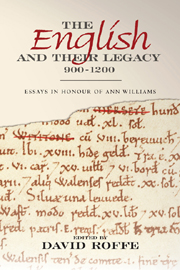Book contents
- Frontmatter
- Contents
- Figures and Tables
- Dedication
- Preface
- Contributors
- Abbreviations
- Ann Williams: a Personal Appreciation
- Life-writing and the Anglo-Saxons
- Meet the Swarts: Tracing a Thegnly Family in Late Anglo-Saxon England
- The Moneyers of Kent in the Long Eleventh Century
- Master Wace: a cross-Channel Prosopographer for the Twelfth Century?
- From Minster to Manor: the Early History of Bredon
- Eadulfingtun, Edmonton, and their Contexts
- The Family of Wulfric Spott: an Anglo-Saxon Mercian Marcher Dynasty?
- The Burial of King Æthelred the Unready at St Paul's
- Eustace II of Boulogne, the Crises of 1051–2 and the English Coinage
- Through the Eye of the Needle: Stigand, the Bayeux Tapestry and the Beginnings of the Historia Anglorum
- Robert of Torigni and the Historia Anglorum
- Invoking Earl Waltheof
- Hidden Lives: English Lords in post-Conquest Lincolnshire and Beyond
- Lordship and Lunching: Interpretations of Eating and Food in the Anglo-Norman World, 1050–1200, with Reference to the Bayeux Tapestry
- The Exchequer Cloth, c. 1176–1832: the Calculator, the Game of Chess, and the Process of Photozincography
- Ann Williams: a Bibliography 1969–2011
- Index
- Tabula Gratuloria
Eustace II of Boulogne, the Crises of 1051–2 and the English Coinage
Published online by Cambridge University Press: 05 April 2013
- Frontmatter
- Contents
- Figures and Tables
- Dedication
- Preface
- Contributors
- Abbreviations
- Ann Williams: a Personal Appreciation
- Life-writing and the Anglo-Saxons
- Meet the Swarts: Tracing a Thegnly Family in Late Anglo-Saxon England
- The Moneyers of Kent in the Long Eleventh Century
- Master Wace: a cross-Channel Prosopographer for the Twelfth Century?
- From Minster to Manor: the Early History of Bredon
- Eadulfingtun, Edmonton, and their Contexts
- The Family of Wulfric Spott: an Anglo-Saxon Mercian Marcher Dynasty?
- The Burial of King Æthelred the Unready at St Paul's
- Eustace II of Boulogne, the Crises of 1051–2 and the English Coinage
- Through the Eye of the Needle: Stigand, the Bayeux Tapestry and the Beginnings of the Historia Anglorum
- Robert of Torigni and the Historia Anglorum
- Invoking Earl Waltheof
- Hidden Lives: English Lords in post-Conquest Lincolnshire and Beyond
- Lordship and Lunching: Interpretations of Eating and Food in the Anglo-Norman World, 1050–1200, with Reference to the Bayeux Tapestry
- The Exchequer Cloth, c. 1176–1832: the Calculator, the Game of Chess, and the Process of Photozincography
- Ann Williams: a Bibliography 1969–2011
- Index
- Tabula Gratuloria
Summary
The crises of 1051–2 brought out into the open the question of succession to the throne and rendered more acute the fear of foreign influence in the Anglo-Saxon state. Events, in their turn, aggravated existing dissensions over the distribution of office, lands and power – areas that Ann Williams has done so much to illuminate. Yet, in the maelstrom of these two years, Eustace of Boulogne's intentions on his 1051 visit to England remain mysterious.
Certainly there was cause for rivalry between the Godwine dynasty and that of Eustace, since both had married into the English royal house. Besides this, however, I suggest that there was also a commercial dimension. In particular, when Count Eustace told King Edward ‘what he wanted’ on his visit to England in 1051, it might have been that he was seeking a weight-standard in England that was compatible with his own coinage, so as to facilitate the Boulogne trade-route to Lotharingia. This aim was in direct conflict with the Godwine family's Danish associations, their Flemish alliances and the encouragement of trade via the more northerly route towards the developing Bruges and more northerly ports. To ease the paths of commerce, they, in their turn, may have advocated a weight-standard related to the coinage of Flanders.
Shipping and trade between England and the continent in the eleventh century was normally conducted between ports facing each other across the Channel, giving the county of Boulogne a special relationship with Dover. The Godwinesons’ strength, too, lay not only in land but in shipping.
- Type
- Chapter
- Information
- The English and their Legacy, 900–1200Essays in Honour of Ann Williams, pp. 149 - 158Publisher: Boydell & BrewerPrint publication year: 2012

